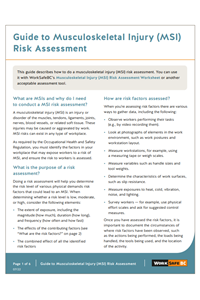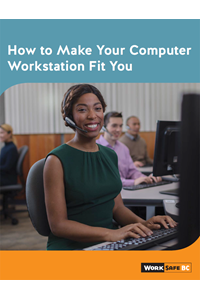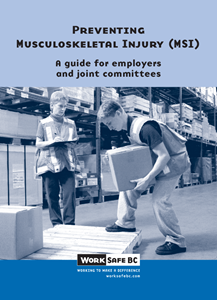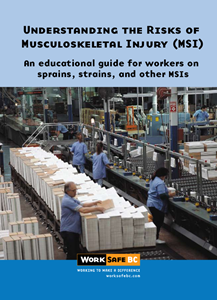Ergonomics
Ergonomics is about interactions between people and their physical and organizational environments. When people's workplace conditions and job demands match their capabilities, safety and productivity improve. Ergonomics can reduce the risk of strains and sprains and other related musculoskeletal injuries (MSIs). MSI is the most common work-related injury in B.C.
- What is a musculoskeletal injury?
- The risks
- Assessing the risks
- How to reduce the risks
- Resources
What is a musculoskeletal injury?
Musculoskeletal injury (MSI) is an injury or disorder of the muscles, tendons, ligaments, joints, nerves, blood vessels or related soft tissue including a sprain, strain and inflammation, that may be caused or aggravated by work.
MSIs can affect the body’s soft tissues: the muscles, tendons, ligaments, nerves, blood vessels, and joints of the neck, shoulders, arms, wrists, legs, and back.
The risks
The main physical risk factors for MSIs associated with the demands of a job include:
- Force — exerting force on an object as part of a task
- Repetition — doing a task that uses the same muscles over and over with little chance for rest or recovery
- Work posture — the position of different parts of the body when taken outside of the comfortable range of motion (awkward posture); usually combined with static posture (i.e., holding a posture for a long time)
- Local contact stress — a hard or sharp object coming in contact with the skin
For each of these risk factors, it is important to consider magnitude, frequency, and duration of exposure.
Assessing the risks
Employers must conduct risk assessments for MSIs in their workplace, and eliminate or minimize the risks. Employers must also educate and train workers about MSI risks in the workplace.
To get started, use our Guide to Musculoskeletal Injury (MSI) Risk Assessment and Musculoskeletal Injury (MSI) Risk Assessment Worksheet. These can help guide your assessment of the extent of a worker's exposure to the main physical risk factors to determine how great a risk a particular task poses. For example, a repetitive motion required throughout a worker's shift poses a greater risk, than a motion that is required for only a few minutes each shift.
You can also use our lift/lower calculator to estimate whether a lift has a low, moderate, or high risk of injury.
To estimate the suggested maximum force that can be used during pushing and pulling, and the weight that can be carried, refer to our push/pull/carry calculator.
How to reduce the risks
Once you have completed a risk assessment you then need to eliminate the risk factors, where practicable, using risk controls. There are so many variables involved in MSIs, it’s not always possible to eliminate the risk factors. If it is not possible to eliminate the risk, then the risk must be minimized.
When choosing the appropriate risk controls, the employer must consult with the joint health and safety committee or the worker health and safety representative. Be sure to test the risk control before fully implementing to make it work within your organization. To help identify potential risk controls, consider the following questions:
-
1
Engineering controls
Physical modifications to facilities, equipment, and processes can reduce risk factor for MSIs. Some question to consider:
- Can mechanical lifting aids such as hoists, pallet jacks, carts, or conveyors be used instead of manual material handling?
- Can the load be lifted within the range of knee to waist height?
- Can the vertical distance the load has to be lifted or lowered be shortened? Options may include limiting shelf height, and raising the worker.
- Can stooped or twisted positions be avoided by providing unrestricted work space, or arranging the workspace differently?
- Can the size of the load be made smaller? Options include ordering smaller containers, or having workers make two trips with smaller loads rather than one trip with a heavy load.
- Can carrying distance be shortened by changing the workflow?
- Can equipment or furniture be modified to eliminate or reduce awkward postures for workers?
- Can the workplace be modified to eliminate or reduce the need for lifting of heavy objects?
-
2
Administrative controls
Changing work practices and work policies, awareness tools, and training can limit the risk of sprains and strains. Some questions to consider:
- Can workers rotate between tasks involving different muscles, for example, stacking boxes and driving a forklift?
- Can workers use safe work procedures to minimize risk factors, for example, using neutral wrist posture while pushing a cart?
- Can workers be trained to perform the tasks using neutral postures?
- Can storage space be organized so that heavy items are located between knee and waist height and light items above shoulder height?
- Can the task design be changed? Examples include changing a lifting task into a lowering task, or changing a carrying task to a pushing or pulling task.
- Can workers be given time to rest or recover when lifting or handling loads?
- Can work demands and work pace be balanced more effectively?
-
3
Personal protective equipment
Personal protective equipment (PPE) can only be used when engineering or administrative controls can’t be applied. Some questions to consider:
- Do workers have suitable gloves that fit properly? For example, they may need padded, friction-enhanced or vibration-limiting gloves.
- If workers are required to kneel, do they have knee pads or a kneeling pad?
- Do workers have warm clothing if they have to work in cold conditions?
Ergonomics Enews
- Ergonomics Enews for March 2024 Published on: March 29, 2024
- Ergonomics Enews for October 2023 Published on: October 10, 2023
- Ergonomics Enews for March 2023 Published on: March 31, 2023
- Ergonomics Enews for October 2022 Published on: October 20, 2022







